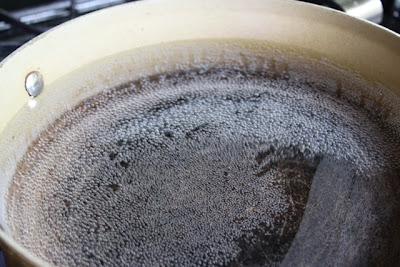Sunday, August 28, 2011
How to Poach an Egg
I don't know about you, but when we eat out for breakfast I almost always order Eggs Benedict if I see it on the menu. To me, it's a gourmet item and I love to taste the many variations on this classic dish. I've had it topped with seafood specialties like crab and lobster, or the traditional canadian bacon swapped with other proteins like deli ham or bacon. My favorite spin is the Eggs Benedict with a Mexican flair - think spicy hatch chile strips or poblano Hollandaise.
When I made Eggs Benedict for the first time it took me a couple tries to get the eggs poached correctly - so my advice to you would be to start with a dozen. Maybe you have one of those fancy egg poaching machines or have a do-hickey that makes the task foolproof. I didn't use anything fancy, here is what I did...
I took a saute pan, filled it with about 3/4-full of water and added a splash (about a tablespoon) of white vinegar. The vinegar helps the egg whites coagulate quickly so everything stays in place. Turn the heat to medium and watch for little bubbles to form on the bottom and sides of the pan.
Notice this is NOT boiling! Try to keep the temp right here, turning it down if you start to get more than just a few bubbles hitting the surface.
Next, I took my spatula and made the water swirl.
I carefully cracked an egg in a small bowl to make it easier to slide the egg down into the pan. With the water swirling, I carefully tip the egg into the center of the pan and let the swirling water keep the egg white together in the center.
After 30-45 seconds when the water slows down I very carefully take a silicone spatula and slide underneath the egg to make sure it's not sticking to the bottom of the pan. I do this VERY gently.
I've found that the egg needs just about 4 minutes. The yolk will still be a little jiggly and the whites of the egg will be coagulated. Use a slotted spoon to remove the egg.
Place on a paper towel to drain.
Don't freak if your egg looks like this when you put it in the pan. I lost a little of the egg white, but the finished poached egg still looked beautiful. When this happened, I simply finished the egg and started with a new pan of water for my second poached egg.
The 4-minute cooking time will give you a gently cooked egg with a gooey yolk that still has a liquid center. To me, it's perfect when you slice down the middle and the bright egg yolk runs out. Adjust the time if you want it more cooked.
Poaching eggs is one of the quickest and lowest calorie ways of preparing eggs, as there is no added fat. Poached eggs are not only the key ingredient to Eggs Benedict, they are great additions to salads, sandwiches or simply served with toast.
My next post will be how to make homemade hollandaise sauce. Trust me, you will never use a dry packaged mix again!
Subscribe to:
Post Comments (Atom)
















great tutorial on how to poach an egg, and your hollandaise sauce looks divine :) You have a very nice blog, I've been looking around,reading and enjoying your writing and stories. I added you to my reader because I plan on trying several recipes.
ReplyDeleteThanks for sharing this Post, Keep Updating such topics.
ReplyDeletesafariors